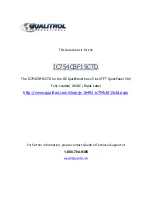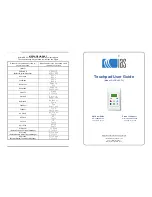
6
7
INSTALLATION AND OPERATION MANUAL SOLAR MODULES Q.MAXX-G2 – Q CELLS
INSTALLATION AND OPERATION MANUAL SOLAR MODULES Q.MAXX-G2 – Q CELLS
Installation Site
Please note the following guidelines that apply to the installation
site:
•
The modules have been tested according to IEC 61215.
•
Solar modules are not explosion-proof and are not suitable
for use in explosive environments.
Ä
Do not operate solar modules near highly flammable gas and
vapors (e.g. gas tanks, gas stations).
Ä
Do not install modules in enclosed space.
Ä
Do not install modules in locations where they may be sub-
merged in water (e.g. floodplains).
Ä
Do not use modules as a substitute for the normal roofing
(e.g. modules are not watertight).
Ä
Do not install modules in close proximity to air conditioning
systems.
Ä
Do not install modules above 4,000 m (13120 ft) altitude
above sea level.
Ä
In locations with increased salt content in the air (e.g. close to
the sea) special precautions must be taken (see „Grounding“
and „Maintenance and Cleaning“).
Ä
Do not bring any chemical substance (e.g. oil, solvent etc.)
into contact with any part of the panel. Only substances,
which are released by Q CELLS, are allowed to be used during
installation, operation and maintenance.
Ä
Any installation of modules on surfaces of water is prohibited.
This includes installations on floating as well as pile-based
platforms. Q CELLS may extend the coverage of its warranty
to such installations, based on a case by case assessment of
the system design and location. A prior written consent by
the warrantor is required in any case.
The solar modules are designed for the following applications:
•
Operating temperatures from –40 °C to +85 °C
(–40 °F to +185 °F).
•
Pull loads up to max. 2,400 Pa and push loads up to max.
5,400 Pa (see chapter „Mounting Options“).
•
Installation using a mounting structure for solar modules.
Prevention of Shadowing Effects
Optimal solar irradiation leads to maximum energy output:
Ä
For this reason, install the modules so that they face the sun.
Ä
Avoid shadowing (due to objects such as buildings, chimneys
or trees).
Ä
Avoid partial shading (for example through overhead lines,
dirt, snow).
Mounting Structure Requirements
The Modules shall be installed and operated on mounting structures
that comply with any applicable laws and stipulations as well as
with the following:
•
Conform to the necessary structural requirements.
•
Compliant with local snow and wind loads.
•
Properly fastened to the ground, the roof, or the façade.
•
Forces acting on the module are relayed to the mounting
substructure.
•
Ensures sufficient rear ventilation of the module.
•
Avoid the usage of different metals to prevent contact corrosion.
•
Allows for stress-free expansion and contraction due to tem-
perature fluctuations.
Ä
Ensure that no additional forces are applied through the
mounting system into the module except for the wind and
snow loads. Additional forces and moments of torque at the
mounting positions caused by torsions, displacements or
vibrations in the mounting system are not allowed.
Ä
Ensure that the clamps and the mounting frame are com-
patible.
Clamp System Requirements
Use customary clamps that satisfy the following requirements:
•
Clamp width: ≥ 40 mm.
•
Clamp height compliant with a 32 mm frame height.
•
Clamp depth: 7-12 mm. (applicable for all CL clamping mounting
options at section „2.3 Mounting Options“)
•
Clamps are not in contact with the front glass.
•
Clamps do not deform the frame.
•
Clamps that satisfy the structural requirements of the instal-
lation site.
•
Long-term stable clamps that securely affix the module to
the mounting frame.
Module Orientation Requirements
•
Vertical or horizontal installation is permitted.
Ä
Ensure that rain and melting snow can run off freely. No water
accumulation.
Ä
Ensure that the drainage holes in the frame are not covered.
No sealing.
75°
3°
Ä
Maintain the permissible angle of inclination.
•
Minimum angle of inclination: 3°
•
Inclination angles above 75° may be limited
by local regulations
Ä
≥ 20°: self-cleaning effect
Ä
Follow the directions for installation angles < 5°
(„Grounding“, 18)
Fig. 2:
Installation options for crystalline Q CELLS modules. All dimensions are given in mm. Also observe the maximum
test loads and clamping range as specified on the following page.
The illustrated installation options apply for both horizontal and vertical module orientation.
Module
Clamp
Subconstruction
Mounting profile
TYPE OF
INSTALLATION
MODULE
POINT MOUNTING SYSTEM
LINEAR MOUNTING SYSTEM
INSTALLATION
WITH CLAMPS
Q.MAXX-G2
HYBRID
CLAMPING
Q.MAXX-G2
INSTALLATION
ON MOUNTING
POINTS
Q.MAXX-G2
INSTALLATION
WITH INSERTION
PROFILES
Q.MAXX-G2
NOT PERMITTED
2 PLANNING
2.2 REQUIREMENTS
2 PLANNING
2.3 MOUNTING OPTIONS
300 - 450
EUROPE
0 - 250
CL5
CL2a
0 - 300
CL2b
0 - 300
0 - 300
CL2a
0 - 300
CL2b
CL2a
0 - 200
CL2b
0 - 200
IP1
IP2
IP1
IP2
IP1
IP2
IP1
IP2
CL2a
0 - 300
CL2b
0 - 300
0 - 300
CL2a
0 - 300
CL2b
CL2a
0 - 200
CL2b
0 - 200
EN
4 × Mounting
points
380
FB2
EN
4 x Mounting
points
380
FB1
CL1
0 - 250
250 - 450
450 - 550
0 - 200
200 - 350
350 - 450
EUROPE
ASIA
CL1
CL3
CL4
250 - 450
200 - 350
0 - 300
0 - 300
CL3
CL4
CL4
0 - 200
ROW
CL3
200 - 350





























